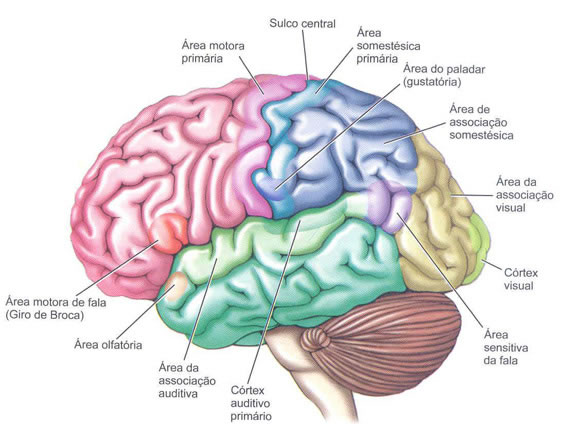telencephalon
The telencephalon comprises the two cerebral hemispheres, right and left, and a small midline located in the anterior portion of the third ventricle.
The two cerebral hemispheres are incompletely separated by the longitudinal fissure of the brain, whose floor is formed by a wide band of commissural fibers, called corpus callosum, the main means of union between the two hemispheres. The hemispheres have cavities, the right and left lateral ventricles, which communicate with the third ventricle through the interventricular foramina.
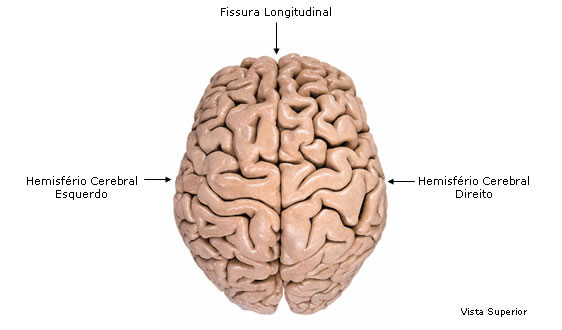
Each hemisphere has three poles : Frontal, Occipital and Temporal ; and three faces : Superolateral (convex); Medial (flat); and Inferior or base of the brain (irregular), resting anteriorly on the anterior and middle floors of the skull base and posteriorly on the tent cerebellum.
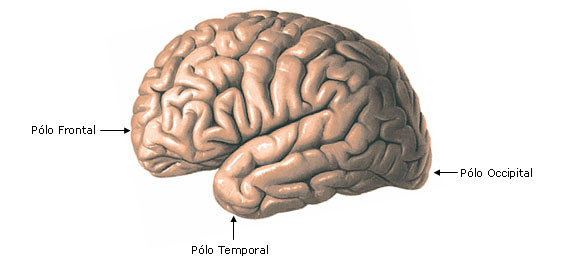
Grooves and Gyres :
During embryonic development, when the size of the brain increases rapidly, the gray matter of the cortex increases more rapidly than the underlying white matter. As a result, the cortical region curls and folds in on itself. Therefore, the surface of the brain of man and of several animals presents depressions called sulci, which delimit the cerebral gyri or convolutions. The existence of the sulci allows a considerable increase in brain volume and it is known that about two thirds of the area occupied by the cerebral cortex is “hidden” in the sulci.
In any hemisphere, the two most important sulci are the lateral sulcus and the central sulcus.
Lateral sulcus : it is the sulcus that separates the frontal lobe from the temporal lobe. It is subdivided into ascending, anterior and posterior.
Central sulcus : separates the parietal from the frontal lobe. The central sulcus is flanked by two parallel gyri, one anterior, the precentral gyrus, and the other posterior, the postcentral gyrus. The areas located in front of the central groove are related to MOTRICITY, while those located behind this groove are related to SENSITIVITY.
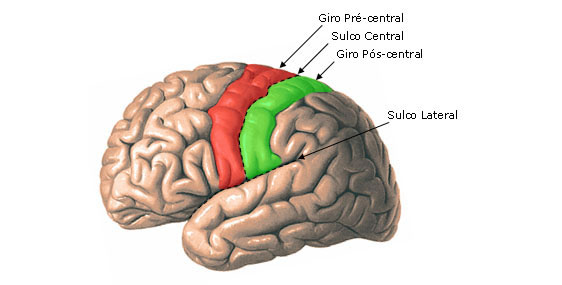
Another important sulcus located in the telencephalon, on the medial aspect, is the Parieto-occipital sulcus , which separates the parietal from the occipital lobe.

The division of the lobes does not correspond very much to a functional division, except for the occipital lobe which seems to be related only to vision.
The frontal lobe is located above the lateral sulcus and in front of the central sulcus. On the medial surface of the brain, the anterior limit of the occipital lobe is the parieto-occipital sulcus. On its superolateral surface, this limit is arbitrarily located on an imaginary line that joins the termination of the parieto-occipital sulcus, on the upper edge of the hemisphere, to the preoccipital notch, located on the inferolateral edge, about 4 cm. from the occipital pole. From the middle of this imaginary line departs a second imaginary line towards the posterior branch of the lateral sulcus and which, together with this branch, limits the temporal lobe of the parietal lobe.


Superolateral face :
 |  |  |  |  | ||||
| frontal lobe | temporal lobe | parietal lobe | occipital lobe | insula wolf |
Front Lobe :
Grooves :
Precentral sulcus : more or less parallel to the central sulcus.
Superior Frontal Sulcus : It starts in the superior portion of the precentral sulcus and goes anteriorly in the frontal lobe. It's perpendicular to it.
Inferior Frontal Groove : Starting from the lower portion of the precentral groove, it runs forward and downward.

Spins :
Precentral gyrus: located between the central sulcus and the precentral sulcus. The main motor area of the brain (motor cortex) is located in this gyrus.
Superior Frontal Gyrus: It is located above the superior frontal sulcus.
Middle Frontal Gyrus: located between the superior and inferior frontal sulcus.
Inferior Frontal Gyrus: located below the inferior frontal sulcus. The inferior frontal gyrus of the left hemisphere is the cortical center of the spoken word.

Temporal Wolf :
Grooves:
Superior Temporal Sulcus : It starts near the temporal pole and runs backwards parallel to the posterior branch of the lateral sulcus, ending in the parietal lobe.
Inferior temporal sulcus: parallel to the superior temporal sulcus, it is usually formed by two or more discontinuous parts.

Spins:
Superior Temporal Gyrus: Located between the lateral sulcus and superior temporal sulcus.
Middle temporal gyrus: located between the superior temporal and inferior temporal sulci.
Inferior Temporal Gyrus: It is located below the inferior temporal sulcus and limits with the occipito-temporal sulcus.
Moving the lips away from the lateral sulcus, its floor appears, which is part of the superior temporal gyrus. The upper portion of this floor is traversed by small transverse gyri, the transverse temporal gyri, of which the most evident is the anterior transverse temporal gyrus. This is important because it locates the cortical center of hearing.

Parietal lobe :
Grooves:
Postcentral sulcus : located posterior to the postcentral gyrus. It is parallel to the central groove.
Intraparietal sulcus : It is usually located perpendicular to the postcentral sulcus (with which it may be united) and extends backwards to end in the occipital lobe.
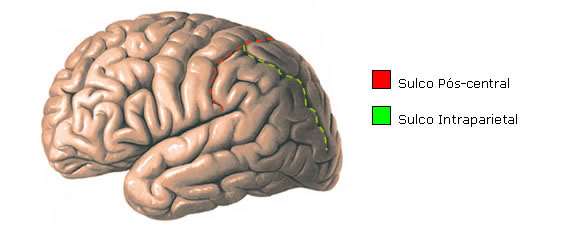
Postcentral gyrus: located between the central sulcus and the postcentral sulcus. It is in the postcentral gyrus that one of the most important sensory areas of the cortex, the somesthetic area, is located.
Superior Parietal Lobe: It is located superior to the intra-parietal sulcus.
Inferior Parietal Lobe: Located inferior to the intraparietal sulcus. In it, two gyri are described: the supramarginal gyrus, curving around the tip of the posterior branch of the lateral sulcus, and the angular gyrus, curving around the terminal and ascending portion of the superior temporal sulcus.

Occipital Lobe :
The occipital lobe occupies a relatively small portion of the superolateral surface of the brain, where it has small grooves and irregular and inconstant gyri. The main sulci and gyri of this lobe are visualized on the medial aspect of the brain.
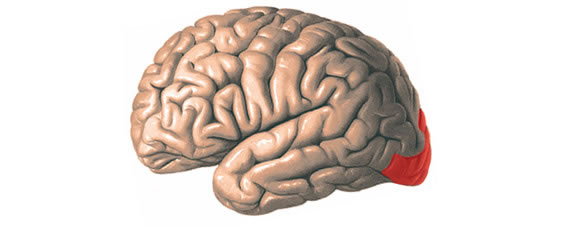
Insula Wolf :
The insular lobe is visualized by moving the lips away from the lateral sulcus. The insula has a conical shape and its apex, facing downwards and forwards, is called the insular limen.
Central sulcus of the insula : part of the circular sulcus, in the superior portion of the insula, and runs in the anteroinferior direction. Divides the insula into two parts: long gyri and short gyri.
Circular sulcus of the insula: surrounds the insula at its upper edge.
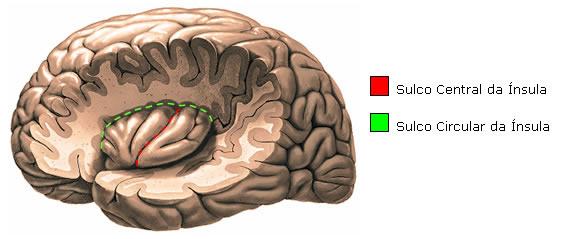
Spins:
Long gyri of the insula : they are located posterior to the central sulcus of the insula.
Short Insula Gyres: They are located anterior to the central sulcus of the insula.
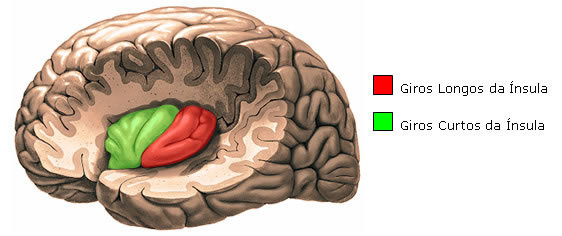
| SUMMARY OF THE TURNS OF THE BRAIN SUPERO-LATERAL FACE |
 |
| Source: NETTER, Frank H.. Atlas of Human Anatomy. 2nd edition Porto Alegre: Artmed, 2000. |
| SUPEROLATERAL FACE OF THE BRAIN |
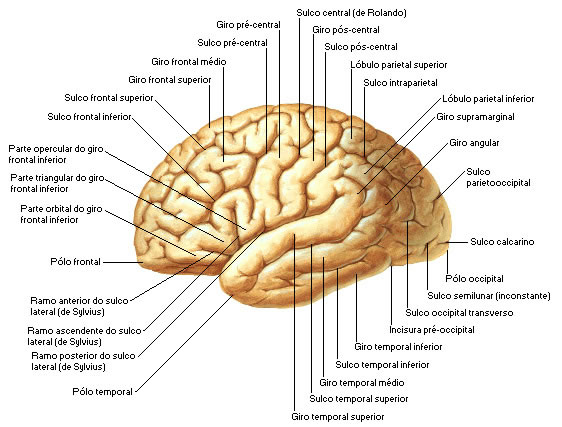 |
| Source: NETTER, Frank H.. Atlas of Human Anatomy. 2nd edition Porto Alegre: Artmed, 2000. |
| INSULA LOBO |
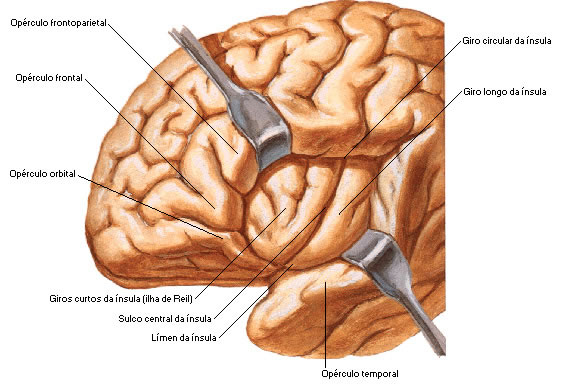 |
| Source: NETTER, Frank H.. Atlas of Human Anatomy. 2nd edition Porto Alegre: Artmed, 2000. |
Medial Face :
 |  |  | ||
| corpus callosum fornix pellucid septum | frontal lobe parietal lobe | occipital lobe
|
Corpus callosum, fornix and septum pellucidum :
Corpus Callosum : It is the largest of the interhemispheric commissures. It is formed by a large number of myelin fibers that cross the midsagittal plane and penetrate the medullary white center of the brain on each side, joining symmetrical areas of the cortex of each hemisphere. In a sagittal section of the brain, we can identify the divisions of the corpus callosum: a dorsally arched white plate, the trunk of the corpus callosum, which dilates posteriorly in the splenium of the corpus callosum and flexes anteriorly towards the base of the brain to form the genu of the brain. corpus callosum. This thins to form the rostrum of the corpus callosum, which continues in a thin lamina, the rostral lamina up to the anterior commissure. Between the anterior commissure and the optic chiasm is the lamina terminalis, a thin lamina of white matter that also unites the hemispheres and constitutes the anterior limit of the third ventricle.
| DIVISIONS OF THE CORPUS CALLOSUM AND FORNIX - INFERO-MEDIAL FACE OF THE BRAIN |
 |
| Source: NETTER, Frank H.. Atlas of Human Anatomy. 2nd edition Porto Alegre: Artmed, 2000. |
| |
Fornix : emerging below the splenium of the corpus callosum and arching towards the anterior commissure is the fornix, a complex bundle of fibers which, however, cannot be seen in its entirety in a sagittal section of the brain. It consists of two lateral and symmetrical halves, spaced apart at the ends and joined together in the path of the corpus callosum. The intermediate portion where the two halves come together constitutes the body of the fornix and the extremities that separate are, respectively, the columns of the fornix (anterior) and the branches of the fornix (posterior). The fornix columns terminate in the corresponding mammillary body crossing the lateral wall of the III ventricle. The fornix branches diverge and penetrate on each side into the inferior horn of the lateral ventricle, where they attach to the hippocampus. At the point where the fornix legs separate, some fibers pass back and forth, forming the fornix commissure.
| FORNIX AND HIPPOCAMPUS |
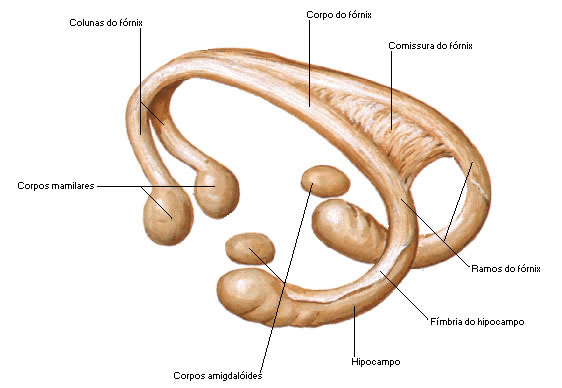 |
| Source: NETTER, Frank H.. Atlas of Human Anatomy. 2nd edition Porto Alegre: Artmed, 2000. |
| TOP VIEW OF FORNIX AND HIPPOCAMPUS |
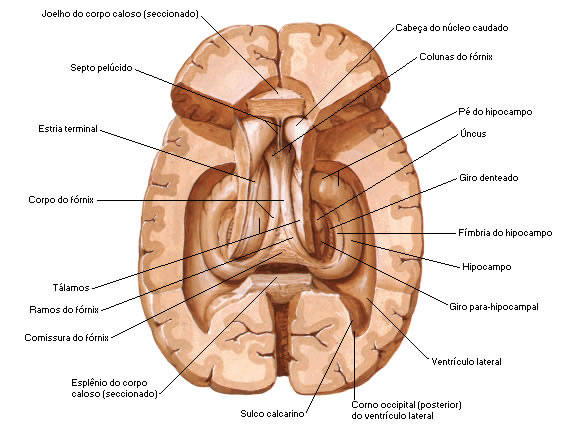
|
| Source: NETTER, Frank H.. Atlas of Human Anatomy. 2nd edition Porto Alegre: Artmed, 2000. |
Pellucid Septum :
 The septum pellucidum extends between the corpus callosum and the fornix, consisting of two thin sheets of nervous tissue that delimit a very narrow cavity, the cavity of the septum pellucidum. The septum pellucidum separates the two lateral ventricles.
The septum pellucidum extends between the corpus callosum and the fornix, consisting of two thin sheets of nervous tissue that delimit a very narrow cavity, the cavity of the septum pellucidum. The septum pellucidum separates the two lateral ventricles.
Frontal and Parietal Lobes:
| PELLUCID SEPTUM - MEDIAL VIEW OF THE BRAIN |
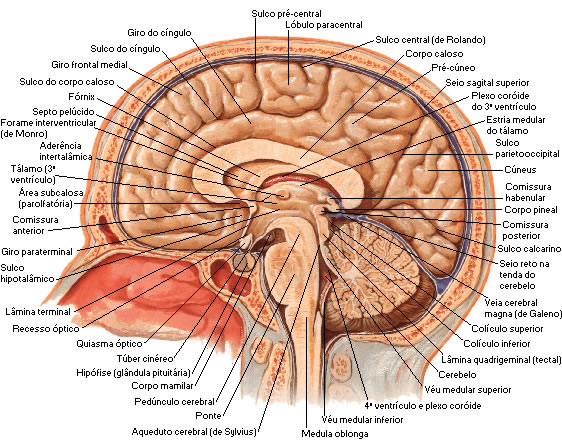 |
| Source: NETTER, Frank H.. Atlas of Human Anatomy. 2nd edition Porto Alegre: Artmed, 2000. |
In the medial part of the brain , there are two grooves that pass from the frontal lobe to the parietal lobe:
Corpus callosum sulcus : begins below the rostrum of the corpus callosum, goes around the trunk and splenium of the corpus callosum, where it continues into the temporal lobe, with the sulcus of the hippocampus.
Cingular sulcus : runs parallel to the sulcus of the corpus callosum, from which it is separated by the cingulate gyrus. It ends posteriorly in two sulci: the marginal branch of the cingulate gyrus, the final portion of the cingulate gyrus sulcus that crosses the upper border of the hemisphere, and the subparietal sulcus, which continues posteriorly towards the parieto-occipital sulcus.
Paracentral sulcus : It stands out from the cingulate sulcus towards the superior margin of the hemisphere, which delimits, with the cingulate sulcus and the marginal sulcus, the paracentral lobe.
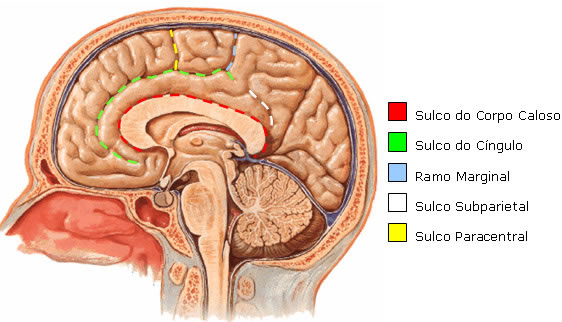
Cingular gyrus : It bypasses the corpus callosum, connecting to the parahippocampal gyrus through the isthmus of the cingulate gyrus. It is traversed by a bundle of fibers, the cingulate fasciculus.
Paracentral lobe : located between the marginal sulcus and the paracentral sulcus. In the anterior and posterior part of this lobe are located the motor and sensory areas related to the leg and foot.
Precuneus : It is located superior to the parieto-occipital sulcus, in the parietal lobe.
Superior Frontal Gyrus: already described above, in the study of the lateral face of the brain.

Occipital Lobe :
Calcarine sulcus : it starts below the splenium of the corpus callosum and has an arcuate course towards the occipital pole. The cortical center of vision is located on the lips of the calcarine sulcus.
Parieto-occipital sulcus : it is the sulcus that separates the occipital lobe from the parietal lobe.
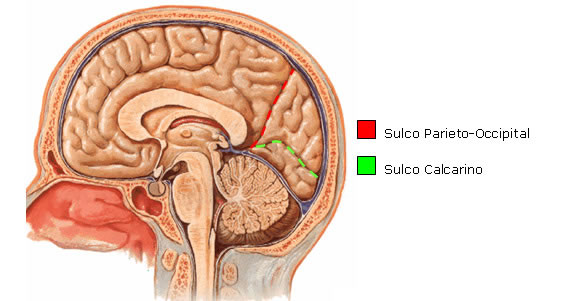
Cuneas : located between the parieto-occipital sulcus and the calcarine sulcus. It is a complex gyrus of triangular shape. In front of the cuneus, in the parietal lobe, we have the precuneus.
Medial Occipito-temporal gyrus : located below the calcarine sulcus. This gyrus continues anteriorly with the parahippocampal gyrus of the temporal lobe.

Bottom Face :
 | 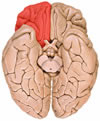 | |
| temporal lobe | frontal lobe |
Temporal Wolf :
Occipito-temporal sulcus : located between the lateral occipito-temporal and medial occipito-temporal gyri.
Collateral sulcus : starts near the occipital pole and runs forward. The collateral sulcus may be continuous with the renal sulcus, which separates the most anterior part of the parahippocampal gyrus from the rest of the temporal lobe.
Hippocampal sulcus : it originates in the region of the splenium of the corpus callosum, where it continues with the sulcus of the corpus callosum and goes to the temporal pole, where it ends up separating the parahippocampal gyrus from the uncus.
Calcarine sulcus : best visualized on the medial surface of the brain. On the inferior surface, the posterior portion separates the parahippocampal gyrus from the isthmus of the cingulate gyrus.

Lateral Occipito-temporal gyrus : It is located in the lateral region of the inferior surface of the brain surrounding the medial occipito-temporal gyrus and the parahippocampal gyrus.
Medial Occipito-temporal gyrus : It is also seen on the medial surface of the brain, but occupies a significant area on the inferior surface. It is located between the lateral occipito-temporal gyrus, parahippocampal gyrus and the cingulate isthmus.
Parahippocampal gyrus : It is posteriorly linked to the cingulate gyrus through a narrow gyrus, the isthmus of the cingulate gyrus. Thus, the uncus, the parahippocampal gyrus, the isthmus of the cingulate gyrus and the cingulate gyrus constitute the limbic lobe, an important part of the limbic system, related to emotional behavior and the control of the autonomic nervous system. The anterior portion of the parahippocampal gyrus curves around the hippocampal sulcus to form the uncus.
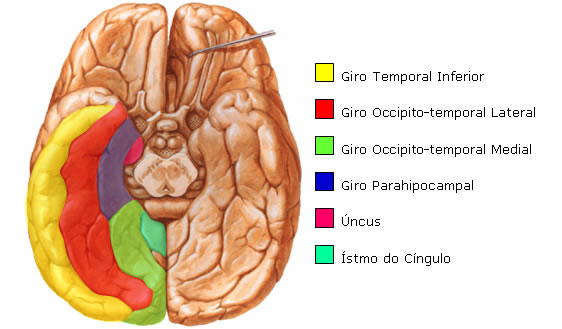
Front Lobe :
The inferior surface of the frontal lobe presents the following structures: the olfactory sulcus , deep and of anteroposterior direction; the rectus gyrus , which lies medial to the olfactory sulcus and continues dorsally as the superior frontal gyrus. The rest of the lower surface of the frontal lobe is occupied by very irregular sulci and gyri, the orbital sulci and gyri.
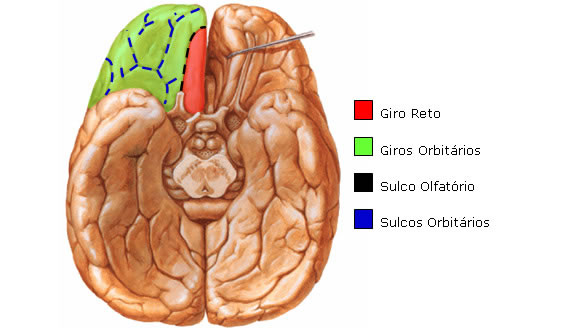
| LOWER FACE OF THE BRAIN |
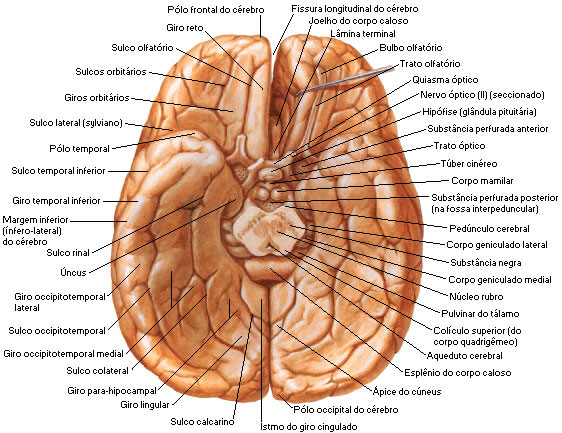 |
| Source: NETTER, Frank H.. Atlas of Human Anatomy. 2nd edition Porto Alegre: Artmed, 2000. |
| SUMMARY OF THE TURNS OF THE MEDIAL FACE OF THE BRAIN |
 |
| Source: NETTER, Frank H.. Atlas of Human Anatomy. 2nd edition Porto Alegre: Artmed, 2000. |
Rhinencephalon :
The olfactory bulb is an ovoid, flat swelling of gray matter that continues posteriorly with the olfactory tract, both housed in the olfactory sulcus. The olfactory bulb receives filaments that make up the olfactory nerve. Subsequently, the olfactory tract bifurcates forming the lateral and medial olfactory striae, which delimit a triangular area, the olfactory trigone. Through the olfactory trigone and ahead of the optic tract is located an area containing a series of small holes for the passage of vessels, the perforated substance of the previous one.
| RHYNENCEFALUS – THE ANATOMY OF THE OLFACTORY NERVE |
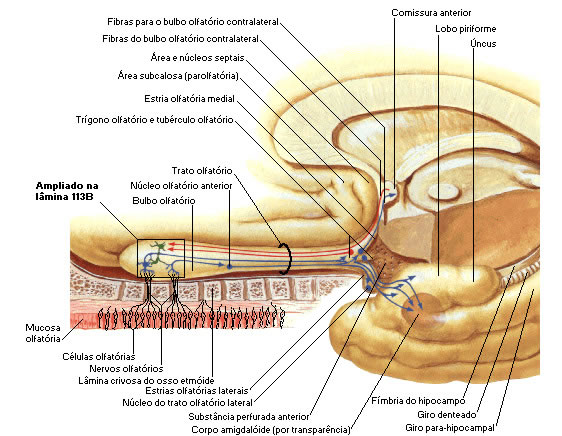 |
| Source: NETTER, Frank H.. Atlas of Human Anatomy. 2nd edition Porto Alegre: Artmed, 2000. |
Morphology of the Lateral Ventricles :
The cerebral hemispheres have cavities lined with ependyma and containing cerebrospinal fluid, the left and right lateral ventricles, which communicate with the third ventricle through the interventricular foramen. Except for the foramen, each ventricle is a closed cavity that has a central part and three horns that correspond to the three poles of the cerebral hemisphere. The parts that project to the frontal, occipital, and temporal poles, respectively, are the anterior, posterior, and inferior horns. With the exception of the inferior horn, all parts of the lateral ventricle have a roof formed by the corpus callosum.
| SIDE VENTRICLE MORPHOLOGY |
 |
| Source: NETTER, Frank H.. Atlas of Human Anatomy. 2nd edition Porto Alegre: Artmed, 2000. |
| SIDE VENTRICLE MORPHOLOGY |
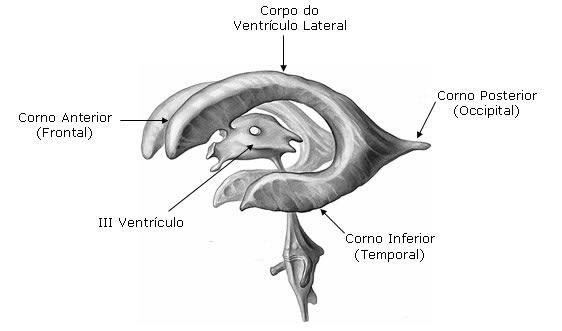 |
| Source: NETTER, Frank H.. Atlas of Human Anatomy. 2nd edition Porto Alegre: Artmed, 2000. |
Internal Organization of the Cerebral Hemispheres:
Each hemisphere has a surface layer of gray matter, the cerebral cortex, which lines a white matter center, the medullary center of the brain, or semioval center. Within this white matter are masses of gray matter, the nuclei at the base of the brain.
Medullary white center of the brain: it is formed by myelinated fibers. Two groups of fibers are distinguished: Projection and Association . Projection fibers link the cerebral cortex to subcortical centers; association fibers link cortical areas located at different points in the brain.
The Projection Fibers are arranged in two bundles: the fornix and the internal capsule.
The fornix joins the hippocampus cortex to the mammillary body and contributes a little to the formation of the medullary white center. It has been better described earlier on this page.
The Internal Capsule contains the vast majority of fibers that leave or enter the cerebral cortex. These fibers form a compact bundle that separates the lentiform nucleus, located laterally, from the caudate nucleus and thalamus, located medially. Above the level of these nuclei, the fibers of the internal capsule form the corona radiata.
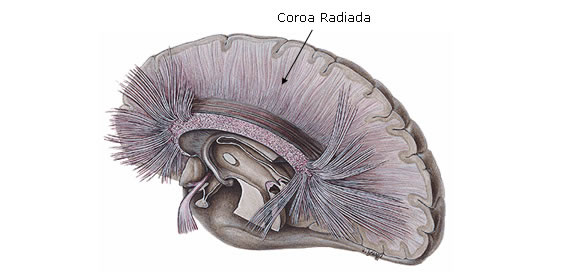
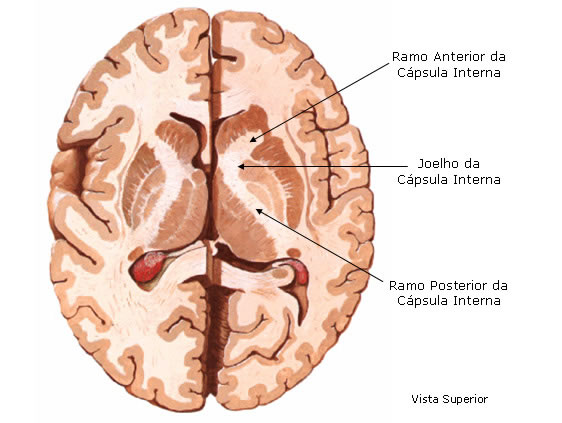
Association fibers are divided into intrahemispheric and interhemispheric association fibers.
Among the Intra-hemispheric Association Fibers , I will cite the four most important issues: ![]() Cingular fasciculus – Unites the frontal and temporal lobes.
Cingular fasciculus – Unites the frontal and temporal lobes. ![]() Superior Longitudinal Fasciculus – Unites the frontal, parietal, and occipital lobes. It may also be called an arcuate fasciculus.
Superior Longitudinal Fasciculus – Unites the frontal, parietal, and occipital lobes. It may also be called an arcuate fasciculus. ![]() Inferior Longitudinal Fasciculus – Unites the occipital and temporal lobes.
Inferior Longitudinal Fasciculus – Unites the occipital and temporal lobes. ![]() Unciform Fasciculus – Unites the frontal and temporal lobes.
Unciform Fasciculus – Unites the frontal and temporal lobes.

Among the Interhemispheric Association Fibers , that is, those that cross the median plane to unite symmetrical areas of the two hemispheres, we find three telencephalic commissures: Corpus Callosum, Commissure of the Fornix and Anterior Commissure , already studied above.
 Base Cores :
Base Cores :

![]() Caudate nucleus : it is an elongated and quite voluminous mass of gray matter, related in its entirety with the lateral ventricles. Its anterior end is very dilated, constituting the head of the caudate nucleus, which protrudes from the floor of the anterior horn of the lateral ventricle. It gradually continues with the body of the caudate nucleus, situated on the floor of the central part of the lateral ventricle. This gradually thins to form the tail of the caudate nucleus, which is long and strongly arcuate, extending to the anterior end of the inferior horn of the lateral ventricle. Because of its strongly arcuate shape, the caudate nucleus appears to be sectioned twice in certain horizontal and frontal sections of the brain. The head of the caudate nucleus fuses with the anterior part of the lentiform nucleus.
Caudate nucleus : it is an elongated and quite voluminous mass of gray matter, related in its entirety with the lateral ventricles. Its anterior end is very dilated, constituting the head of the caudate nucleus, which protrudes from the floor of the anterior horn of the lateral ventricle. It gradually continues with the body of the caudate nucleus, situated on the floor of the central part of the lateral ventricle. This gradually thins to form the tail of the caudate nucleus, which is long and strongly arcuate, extending to the anterior end of the inferior horn of the lateral ventricle. Because of its strongly arcuate shape, the caudate nucleus appears to be sectioned twice in certain horizontal and frontal sections of the brain. The head of the caudate nucleus fuses with the anterior part of the lentiform nucleus.
| CAUDATE NUCLEUS, LENTIFORM NUCLEUS, AND TONSIZED BODY |
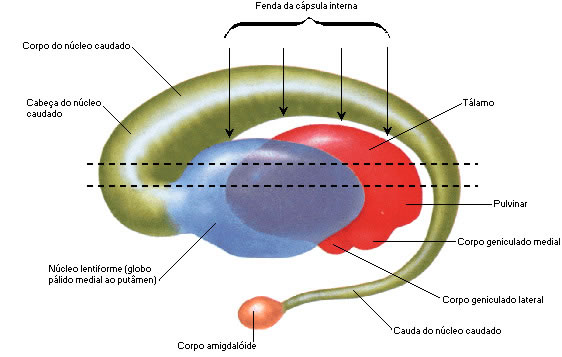 |
| Source: NETTER, Frank H.. Atlas of Human Anatomy. 2nd edition Porto Alegre: Artmed, 2000. |
![]() Lentiform Nucleus : It has the approximate shape and size of a Brazil nut. It does not appear on the ventricular surface, lying deep within the hemisphere. Medially it is related to the internal capsule, which separates it from the caudate nucleus and the thalamus; laterally it relates to the cortex of the insula, from which it is separated by white matter and the claustrum.
Lentiform Nucleus : It has the approximate shape and size of a Brazil nut. It does not appear on the ventricular surface, lying deep within the hemisphere. Medially it is related to the internal capsule, which separates it from the caudate nucleus and the thalamus; laterally it relates to the cortex of the insula, from which it is separated by white matter and the claustrum.
The lentiform nucleus is divided into the putamen and globus pallidus by a thin sheet of white matter, the lateral medullary lamina. The putamen lies laterally and is larger than the globus pallidus, which are disposed medially. In cross-sections of the brain, the globus pallidus is lighter in color than the putamen because of the presence of myelinated fibers running through it. The globus pallidus is subdivided by a lamina of white matter, the medial medullary lamina, into external and internal parts (see figure below).
![]() Cloister : it is a thin cap of gray matter situated between the cortex of the insula and the lentiform nucleus. It is separated from the cortex of the insula by a thin white lamina, the extreme capsule. Between the cloister and the lentiform nucleus there is another white sheet, the external capsule (see figure below).
Cloister : it is a thin cap of gray matter situated between the cortex of the insula and the lentiform nucleus. It is separated from the cortex of the insula by a thin white lamina, the extreme capsule. Between the cloister and the lentiform nucleus there is another white sheet, the external capsule (see figure below).
![]() Amygdaloid Body : It is a spheroid mass of gray matter about 2 cm in diameter located in the temporal pole of the cerebral hemisphere. It makes a slight bulge in the roof of the terminal part of the inferior horn of the lateral ventricle. The amygdaloid body is part of the limbic system and is an important regulator of sexual behavior and aggression (see figure above).
Amygdaloid Body : It is a spheroid mass of gray matter about 2 cm in diameter located in the temporal pole of the cerebral hemisphere. It makes a slight bulge in the roof of the terminal part of the inferior horn of the lateral ventricle. The amygdaloid body is part of the limbic system and is an important regulator of sexual behavior and aggression (see figure above).
![]() Accumbens nucleus : mass of gray matter located in the junction between the putamen and the head of the caudate nucleus.
Accumbens nucleus : mass of gray matter located in the junction between the putamen and the head of the caudate nucleus.
![]() Meynert's basal nucleus : difficult to see macroscopically. It is located at the base of the brain, between the anterior perforated substance and the globus pallidus, a region known as the substantia innominata. Contains large neurons rich in acetylcholine.
Meynert's basal nucleus : difficult to see macroscopically. It is located at the base of the brain, between the anterior perforated substance and the globus pallidus, a region known as the substantia innominata. Contains large neurons rich in acetylcholine.
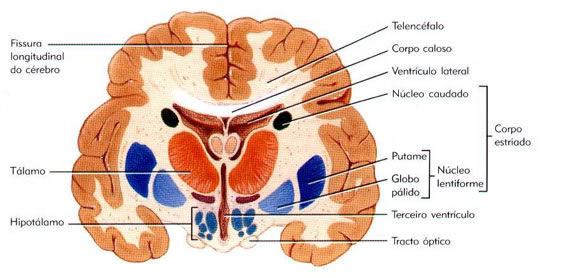
| BASEAL NUCLEUS - CROSS-SECTION OF THE BRAIN |
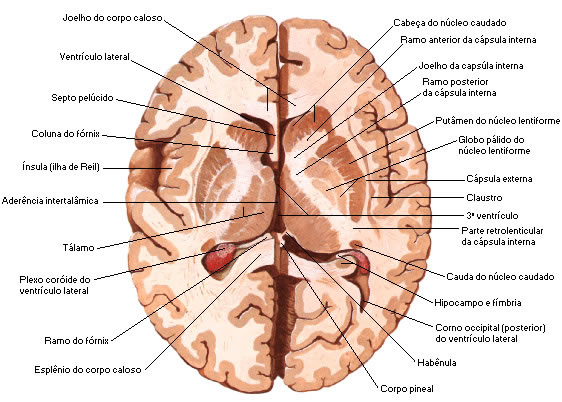 |
| Source: NETTER, Frank H.. Atlas of Human Anatomy. 2nd edition Porto Alegre: Artmed, 2000. |
At the end of this content, I would like to illustrate an image with some important areas considering the telencephalon as a whole. As stated before, the division by lobes and sulci is just didactic, as the brain works as a whole independent of the lobes, but some areas are specific and well located, such as those indicated in the figure below:
